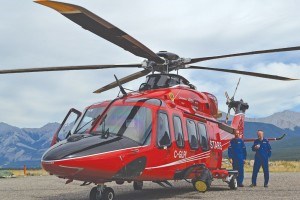
If all goes as planned, in a little more than a year—possibly even sooner—Jasper will have a newly built, completely certified heliport.
And it wont cost the municipality a penny.
According to Glenn Litke, the Alberta Health Services employee managing the project, money for the new heliport will come courtesy of a grant from Alberta Infrastructure, which recently shelled out a large chunk of change to upgrade heliports across the province—following the completion of a Heliport Needs Assessment Report in 2012.
Jasper was one of the places identified as needing a certified heliport, primarily to facilitate the Shock Trauma Air Rescue Society (STARS) landings in town.
STARS operates the helicopters that transfer patients from Seton Healthcare Centre to more advanced trauma centres in places like Edmonton. Currently they land at an uncertified landing pad on the Parks Canada compound, which is a flat gravel surface.
STARS recently bought brand-new, AW-139 helicopters, which have significantly increased their ability to respond to emergencies in Jasper. Because of that, Litke said he would like to see a certified heliport built as soon as possible.
Litke said there are several reasons the uncertified landing spot at the Parks compound isn’t ideal, which is why AHS has scouted out five possible locations in Jasper for a certified heliport to be built.
“Right now we’re at the stage where we need to discuss with the municipality and Parks Canada what options they’d like us to explore,” Litke explained.
He said he is in the process of bringing those organizations together for a meeting, at which point he hopes a location can be finalized. That meeting will take place Dec. 1, after which Litke will put his architects and engineers to work designing the landing pad.
“Then we’ll have a lot more motion in the project, and things will be developing faster,” Litke said.
In a report attached to a letter Litke sent to Mayor Richard Ireland, he outlined the five possible locations. Two of them are directly on the hospital site, while the other three are off-site.
One of the on-site locations is the southeast sloped roof of the Seton Healthcare Centre. This location is close, which means patients won’t have to be transferred by ambulance from the hospital to the helicopter, and provides good flight path clearance. But its high cost and complicated design are significant drawbacks.
The other on-site option is an independent elevated structure directly over the main entrance to the hospital, that would allow traffic to pass beneath it. It boasts similar benefits and drawbacks.
The three proposed offsite locations are the airport, the current uncertified landing pad on the Parks Canada compound, and the east intersection of Yellowhead Highway and Connaught Drive.
These locations are all less expensive, but suffer the drawback of forcing emergency workers to transfer patients via ambulance—a process that can take as long as 15 minutes and can mean the difference between a patients survival or eventual death.
Litke said he hopes to start construction on whatever project is selected in the spring, and depending on what final location is chosen, the heliport could be completed by mid-year. (The Parks Canada site would require only about three weeks of construction, while an on-site location could be more than a year).
STARS new dual-engine helicopters cruise significantly faster than the single-engine crafts they replaced—278 kilometres an hour on average, as opposed to the old 225—which means the organization is a “much more viable option” for emergency services in Jasper.
That has translated into significantly more trips to Jasper this year for its pilots.
In 2012 STARS made two flights into Jasper for patient transfers, and in 2013 it made four. This year, however, the organization made 12 flights into Jasper for patient transfers, often landing at the uncertified heliport.
And while Litke mentioned damage to machines caused by flying gravel and lack of maintenance as problems with the uncertified landing spot, he said the real importance of a certified heliport is the increased standard of record keeping.
He explained that the location of certified heliports is published in the Canada Flight Supplement, the country’s official airport directory. This means that Transport Canada can look at how the machine will land and take off, as well as a bunch of other information.
“All that stuff gets published in a chart for the pilot to use, and he also has contact information [for the heliport]. Whereas an uncertified pad, anyone could be landing there at any time.”
Certified heliports, he explained, have a designated heliport manager ensuring they are kept in perfectly safe condition; someone that will clear debris from the pad, make sure no animals are lingering around, and switch on any lighting the pilots needs to make a landing.
STARS representative Cam Heke said that while STARS helicopters can land anywhere, the organization’s pilots welcome a certified helipad.
“We will certainly use it if it’s there.”
Litke said that at this point all five site options are viable, and the final placement will depend on input from Parks Canada and the municipality. Whatever is decided, he anticipates some form of public engagement will happen before construction begins.
“We want to make sure that we build something that the community is happy with,” he said.
For detailed information on the project, and the five proposed locations download the full report here.
Trevor Nichols
[email protected]
